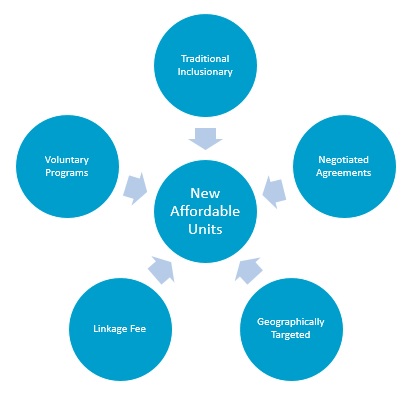There are a number of different program structures that are commonly used to ensure that new market-rate real estate development helps create housing for people at a range of income levels.
Inclusionary Program Types

Traditional Inclusionary Housing
Traditional inclusionary housing programs can be grouped by the type of program (voluntary or mandatory) and development type (homeownership, rental, or both). The distinction between mandatory and voluntary programs lies in whether developers can choose to opt out of the program. In other words, they are required to provide affordable housing in the former and may choose to provide affordable housing in the latter.
A 2021 study found that mandatory programs far outnumber voluntary programs; there are two-and-a-half times as many mandatory programs as voluntary programs. Also, nine out of 10 programs apply to both for-sale and rental developments (Wang and Balachandran, 2021).
Most of these programs are structured as land use requirements. They may allow payment of a fee “in lieu” of providing units on site, but the primary legal requirement is the provision of on-site units.

Negotiated Agreements
Even in communities with no formal inclusionary housing policy, planning commissions or city councils sometimes require provision of affordable housing in high-profile projects. Continue reading

Voluntary Programs
Instead of mandating affordable housing and offering incentives to offset some of the cost, some programs offer incentives to developers that voluntarily provide affordable units. Continue reading

Geographically Targeted Programs
Instead of applying inclusionary requirements throughout a jurisdiction, some programs apply only in targeted areas or impose different requirements in different neighborhoods. Continue reading

Linkage Fee Programs
Instead of requiring on-site units and allowing payment of a fee as an alternative, some programs are structured to simply require payment of a fee directly. Continue reading
Common Questions
An increasingly popular alternative to inclusionary housing programs is to charge a housing development impact fee on new residential development to pay for affordable housing. Typically, fee revenue is deposited in a housing trust fund and used to facilitate construction of additional units for low- and moderate-income households or to achieve other affordable housing goals.
There are some advantages to housing impact fees. In many states that prohibit mandatory inclusionary housing programs, it is permissible to charge fees. Additionally, housing development impact fees have the same advantages as in-lieu fees: they offer flexibility and can be used to leverage other sources of funding, like Federal Low Income Housing Tax Credits. They also face some of the same challenges. For example it is important to make sure the money is not spent primarily in low-income neighborhoods.
To enact a housing development impact fee, cities must first conduct a nexus study that shows the relationship between new housing or jobs and the need for affordable housing. While a nexus study documents the maximum legal fee, a second study, called a feasibility study shows what fee levels will not adversely impact development.
The legal environment is different in every state and it changes rapidly. It is important to consult with an attorney to fully understand if housing development impact fees are permitted in your jurisdiction.
No: Several communities have adopted inclusionary policies through methods other than zoning code amendments. This may be by resolution of municipal council or executive order of the mayor, for example. The decision to adopt inclusionary housing as an ordinance or through resolution should be based on the following:
- If the inclusionary program is to be of limited duration and impact (e.g. applied only to select developments or areas), then a resolution may be appropriate.
- If the inclusionary program is of extended duration and universal impact, then it should be adopted through ordinance.
While adopting a policy as an ordinance can be a cumbersome process, it is less subject to changes due to near-term political shifts and changing priorities of municipal officials. It also provides certainty to developers because the regulations are codified as law with defined requirements and application.
Boston, Massachusetts is one example of an inclusionary development policy that has been adopted by executive order. The policy was first adopted through an executive order of the mayor in the year 2000, requiring a 10 percent affordability component in any residential project of 10 or more units that is financed by or developed on property owned by the city or the Boston Redevelopment Authority (BRA), or where zoning relief is requested. The city is currently in the process of amending their zoning code to incorporate inclusionary zoning to (1) increase developer certainty in its implementation and application and (2) make it a permanent ordinance rather than an executive order that is easily changed by political shifts.


